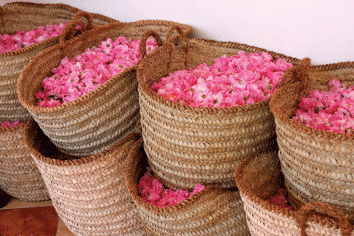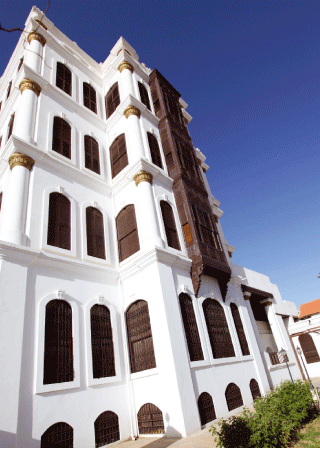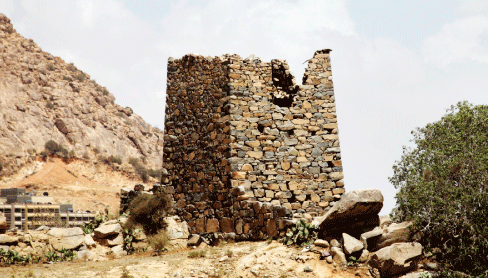
Taif
The City of Roses
 |
For a fun-filled holiday amidst the high hills, green fields and red roses – yes, roses – take a trip to Taif in western Saudi Arabia, where the flowering of the desert is at its best, nearly all the year round.
By Dr. Wafa Ismail Khonkar
Photos Hisham Shamma
Any visit to Saudi Arabia's western region will not be complete without a visit to the lively hills of Taif – the city of roses. Taif's gardens are flush with exquisite roses, a rarity in the arid, desert climate of the immediate neighborhood. The favorable temperatures, abundant groundwater, well-run irrigation systems and the right topsoil have all gone to make Taif the rose garden of Saudi Arabia.
Within a short motorable distance from Makkah and Jeddah, you'll find these red beauties coloring the landscape, particularly the sweet perfumed variety used for centuries to produce the famous essence, 'attar'. The essence is painstakingly extracted, and is a priced gift for anyone held in high esteem by the giver.
Every year, the Taif Municipality in cooperation with the Saudi Commission for Tourism and Antiquities organizes a Flower Festival during the rose-picking season around April. The festival will be in its seventh year this season. Rose oil and rose water are the highlights of the festival, which has always been a major tourist attraction. The event also includes planting of flower beds, children's activities, garden and flower-related programs, art shows, traditional songs, and a photo exhibition.
With the roses and flowers come the bees, making the region a major producer of honey as well. The light-golden colored honey has an extremely pleasing flavor and aroma, and remains fluid. It is undoubtedly a priority on any tourist's shopping list.
The region's honey was showcased for the first time at a Honey Festival in Taif last year. Tourists witnessed demos of honey extraction from beehives, and were briefed on the local beekeeping industry.
Besides growing flowers and producing honey, the farmers of Taif grow wheat, barley and fruits, including apricots, grapes, pomegranates, figs, peaches, watermelons, almonds and dates. Even in ancient times, the region's farmers were known to have used advanced irrigation methods, bringing water drawn from dams.
The name Taif means 'encompassing' in Arabic. For centuries, visitors to this city of hills and mountains have enjoyed the captivating view from wind-sculpted rocks, a pleasant climate and the verdant setting of its surroundings, as well as the abundance of fruits which grow in its fertile valley, lush parks, sunny skies and exotic birds and wildlife.
Its summer climate (around 30 degrees C, with low humidity) makes it a pleasant refuge from extreme dryness of the Kingdom. Not only is Taif popular among vacationers, but has become the official summer seat of the Saudi government.
The history enthusiast can find numerous ruins and antiquities that confirm Taif's colorful history, dating back to pre-Islamic times. Some historians believe the valley was settled over 5,000 years ago. The Banu Mihlahil, a vanished tribe, once inhabited this area, as did the Amalekites and the Thamud, also now extinct. Other tribes, such as the Banu Thaqif, have survived.
Taif began to reemerge on the national scene during the first part of this century. In his drive to unify the tribes and form the modern Kingdom of Saudi Arabia, the nation's founder, late King Abdulaziz, extended his protection to Taif in 1924. Thus the city entered a new era of stability and prosperity.
King Abdulaziz enjoyed the natural setting of Taif and after the unification of the Kingdom in 1932, was a frequent summer resident. Staying at the Shubra Palace, and then later on preferring to reside in an elaborate tent city lower down the mountain, King Abdulaziz and his family enjoyed the refreshing mountain environment. One of the King's favorite pastimes was to visit nearby valleys and plains, where gazelles and other wildlife were in abundance.
Taif is also rich in archaeological sites that date back to the pre-Islamic era. Pictures and writings found on many of the monuments indicate their date and history.
Taif's Souk Okaz has played an illustrious role in the history of Arab poetry before Islam. The Souk was a forum for poetry debate in one of the richest era in the history of Arab literature and culture. In pre-Islamic times, Taif was home to the most famous of annual fairs anywhere on the Arabian Peninsula. Souk Okaz took place on what is now a rolling desert plain north of Taif. Traders brought goods on camels and donkeys to the Souk. Bedouin crafts such as rugs, camel-hair tents, sheepskins, pottery, tools, jewelry, perfumes, produce and spices were sold. Included in this colorful spectacle of the souk were poets and singers who came to participate in contests of their talents. According to Saudi archaeologists who have studied the area, it is believed that the Souk Okaz lasted until sometime around 760 AD.
In 2008, Souk Okaz Festival was revived by Makkah Governor Prince Khalid Al-Faisal. This annual festival offers poetry sessions, music and traditional dance performances, Bedouin handicraft displays and several shopping opportunities.
The Abdullah bin Al-Abbas Mosque is the oldest mosque that was built during the first century of Islam. The mosque has been rebuilt several times, the last of which was during the Ottoman Empire. Its ruins are now an archaeological site. A graveyard near the mosque contains the remains of the 12 martyrs of the Prophet's campaign in 630 AD.
Taif is the city of more than 400 public gardens and parks. The King Fahd Garden, with a total area of around 175,000 sq m is the largest garden in the city. It is designed for the recreation and enjoyment of the citizens. Facilities include children's playgrounds, sheltered seating areas, fountains and a mosque. A lake, 7,200 sq m, features a waterfall running down from the hills, and is spanned by a bridge.
The Al-Rudaf Park is a large natural park located south of Taif where clumps of tree lie scattered amidst magnificent weathered granite rocks. The site also has a small zoo.
Between Al-Hada Hospital and the Meridian Hotel at the top of Al-Hada Mountain is a large nature preserve called Al-Hada, which means tranquility. It is an ideal location to view the sunset over the mountain.
The Al-Shafa Preserve is a small village located high on the Sarawat Mountains, rich in agricultural products. Most of the fruit gardens of Taif are located here.
Taif now covers a total area of about 800 hectares, whereas the area of the city did not exceed two-and-half sq kms in 1951. This is clearly indicative of the vast expansion which the city has witnessed.
Taif is easily accessible. A modern network of roads links the city to Makkah, Madinah and Riyadh. The most important of these roads are Taif-Riyadh and Taif-Makkah-Jeddah road which passes through the high Hada Mountains, and is one of the most outstanding achievements in road construction technology. And when driving through Hada, do not miss the magnificent cable cars – reputed to be the largest undertaking of its kind in the entire Middle East.
• The writer is a member of the Taif Cultural Literary Club.